Introduction to Japanese Gyoza Dumplings
If you're looking to elevate your culinary repertoire, Japanese gyoza dumplings are a must-try. These delightful dumplings might remind you of their Chinese cousins, but they boast unique attributes that make them stand out. Typically made with thinner skins and finely ground beef, gyoza have a delicate texture that melts in your mouth. They're often pan-fried to perfection, offering a satisfying crunch on the outside while keeping the filling juicy and flavorful.
So, what makes these dumplings irresistible? For starters, they are highly versatile. You can fill them with various ingredients—think vegetables, seafood, or even plant-based alternatives—making them suitable for any dietary preference. Plus, they are a wonderful option for gatherings, serving as appetizers or a fun main dish that friends and family will love.
Making gyoza at home isn’t just about the finished product; it’s about the joyful experience of shaping them with your hands. You can also dip them in a tangy sauce for that perfect bite. Ready to dive into the art of crafting Japanese gyoza dumplings? Let's get to the recipe! For more insights into the world of Japanese cuisine, check out NPR’s article on Japanese food culture.
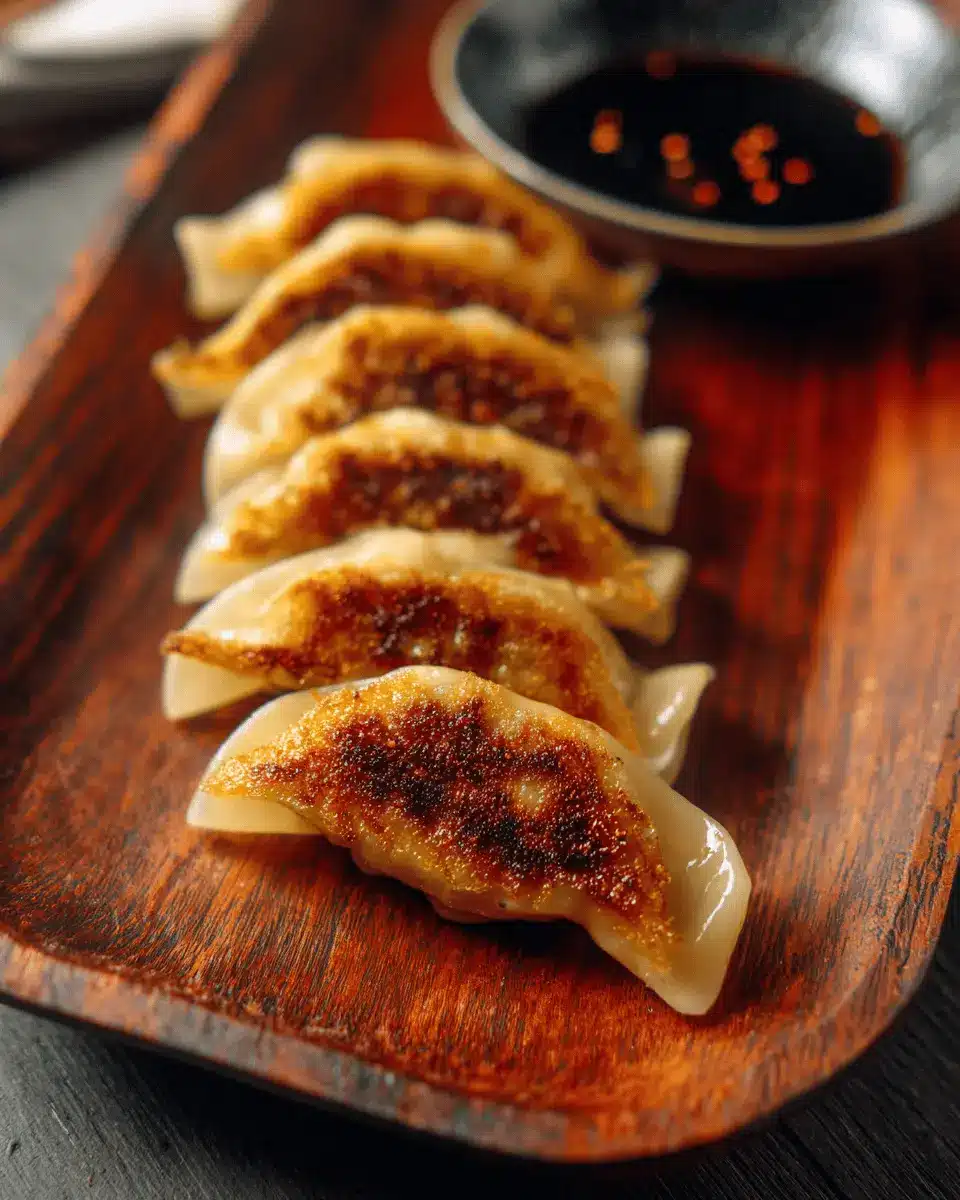
Ingredients for Japanese Gyoza Dumplings
Fresh ingredients for the filling
Creating delicious Japanese Gyoza Dumplings begins with gathering fresh, high-quality ingredients. Here’s what you’ll need for the filling:
- Napa cabbage: This leafy green is essential for adding moisture and flavor. Approximately 1 pound should do the trick.
- Ground beef: Opt for a lean mix (70% to 80% lean) for the best flavor and texture.
- Aromatic seasonings: One clove of garlic and fresh ginger are crucial for that signature gyoza flavor.
- Scallions: These add a mild punch to the filling. Just one, finely chopped, will suffice.
- Oils and sauces: Use vegetable oil and sesame oil, plus soy sauce and sugar for balance.
- Salt and white pepper: These will enhance the overall taste of your filling.
Have you ever wondered how to balance flavors in your dumplings? The secret lies in these fresh ingredients!
Necessary tools and equipment
To make your Japanese Gyoza Dumplings a success, having the right tools is key:
- Food processor: Perfect for blending your filling ingredients smoothly.
- Gyoza wrappers: Store-bought ones save time — look for thin, round options in Asian grocery stores.
- Cooking pan: A nonstick or cast-iron skillet works wonders for that crispy bottom.
- Plastic wrap or parchment paper: Use these for lining your sheet pans while assembling gyoza.
With these fresh ingredients and tools, you'll be well on your way to cooking up a delightful batch of gyoza! For more Japanese cooking tips, check out this resource from Serious Eats.
Preparing Japanese Gyoza Dumplings
Making delicious Japanese gyoza dumplings at home is not only rewarding but also a fun activity to share with friends. Follow these simple steps to create perfectly crispy and flavorful gyoza!
Prepare the napa cabbage and filling
Start by prepping your primary filling ingredient: the napa cabbage. Blanch about 1 pound of roughly chopped napa cabbage in boiling water for 30 seconds. This step helps soften the leaves and makes it easier to incorporate them into the filling. Once blanched, drain the cabbage and rinse it with cold water. Be sure to squeeze out any excess moisture, as you don’t want a watery filling.
Next, time to grab your food processor! Combine the drained napa cabbage with 8 ounces of ground beef, a smashed garlic clove, minuscule but mighty minced ginger, and a finely chopped scallion. For flavor, add in 2 tablespoons of vegetable oil, ½ teaspoon of sesame oil, 2 teaspoons of soy sauce, ¾ teaspoon of sugar, ½ teaspoon of salt, and a dash of white pepper. Pulse the mixture until it’s well-combined and somewhat smooth. Persistent clumps of cabbage are fine—just keep it to a manageable consistency!
Assemble the gyoza
Once your filling is ready, gather your gyoza wrappers. Lay out some sheet pans or cookie sheets lined with plastic wrap or parchment paper to keep your assembled dumplings from sticking. Take about 2 teaspoons of the filling and place it in the center of a wrapper. Dip your finger in a bowl of water and moisten the outer edges of the wrapper for a tight seal. You have options here! You can simply fold them in half or get fancy with some pleats, which not only add flair but also help to seal the filling inside.
Pan-fry and steam the gyoza
Now comes the exciting part—cooking your Japanese gyoza dumplings! Heat a tablespoon of vegetable oil in a nonstick or cast iron skillet over medium-high heat. Carefully place the gyoza in the pan, making sure they don’t touch each other! Fry them for about 2-3 minutes, or until the bottoms are golden and crispy. Once golden, add a tablespoon of water to the pan and immediately cover it to steam the dumplings. After about 2 minutes, lift the lid and let them cook for another minute or so to re-crisp the bottoms. You can’t have soggy gyoza!
Prepare the dipping sauce
While those gyoza are sizzling away, whip up a simple yet delightful dipping sauce. In a small bowl, mix together 2 tablespoons of soy sauce, 1 teaspoon of rice vinegar, 1 tablespoon of hot water, and 1 teaspoon of sugar. Stir until the sugar dissolves. Voila! Your savory dipping sauce is ready to complement those crispy dumplings.
With these straightforward steps, you’ll be devouring your homemade Japanese gyoza dumplings in no time! For more inspiration, check out additional recipes on culinary sites like Serious Eats or Bon Appétit.
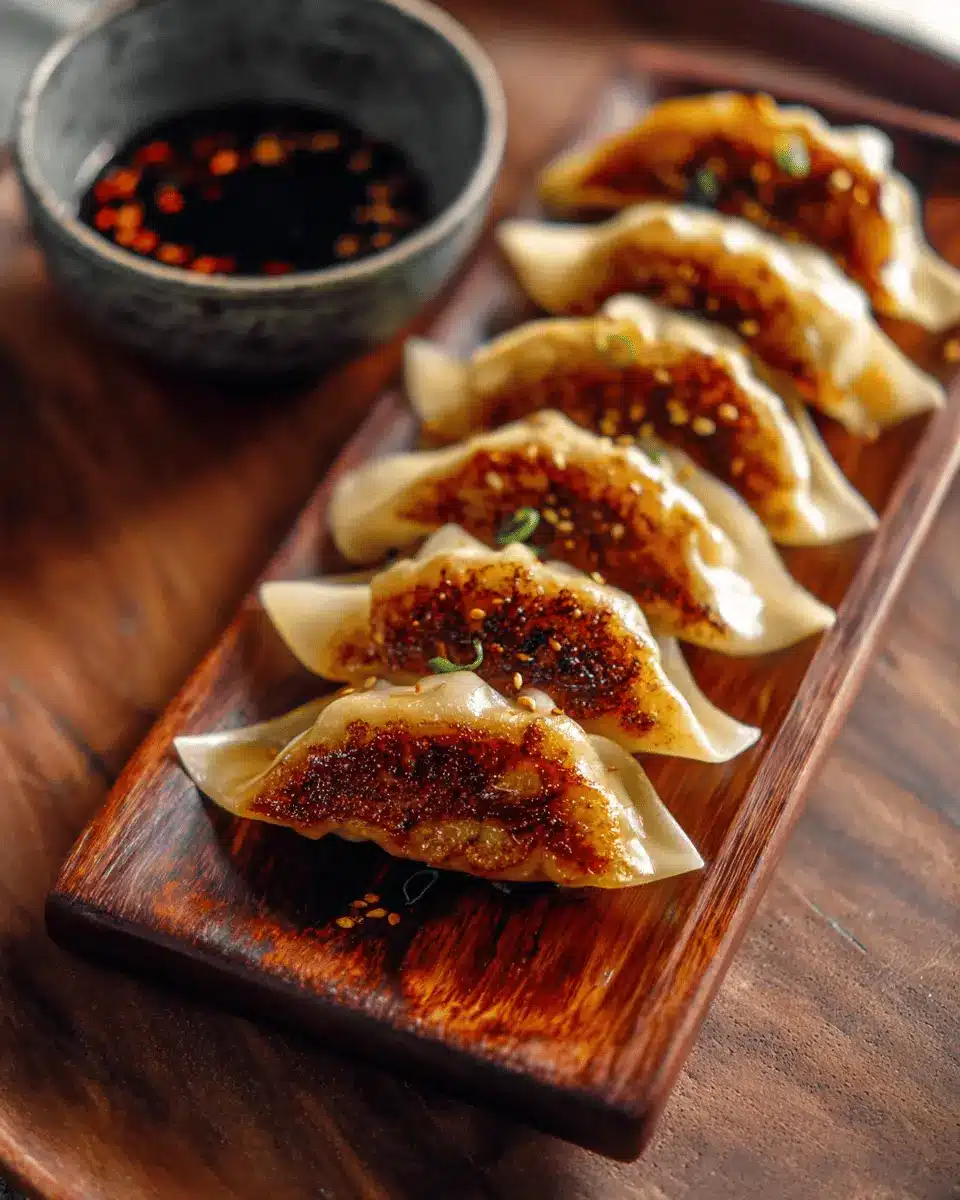
Variations on Japanese Gyoza Dumplings
Vegetarian Gyoza Variations
For those looking to enjoy a meat-free experience, vegetarian Japanese gyoza dumplings can be just as delicious! Consider using a mix of finely chopped mushrooms, carrots, and tofu as your filling. You can also try incorporating ingredients like spinach, bean sprouts, and even kimchi for a spicy twist. These not only add vibrant colors but also provide hearty textures and flavors.
Alternative Meat Options for Filling
Feeling adventurous? Swap out traditional beef for alternatives like turkey bacon for a leaner option, or use chicken ham for a unique flavor. You can also experiment with ground chicken or even seafood, like shrimp or crab, making your gyoza versatile and suitable for various palates. Each of these options offers a fresh take on the classic gyoza, so you can cater to your guests' preferences while maintaining that delightful, crispy exterior!
Cooking tips and notes for Japanese Gyoza Dumplings
Achieving the perfect crispy base
To get that golden, crispy base on your Japanese gyoza dumplings, use a nonstick or cast iron skillet for even heat distribution. Start with medium-high heat and add a tablespoon of oil before placing the dumplings in the pan. Fry until the bottoms are crispy (about 2-3 minutes), then add water and cover to steam. Once the water evaporates, uncover the pan for a final crisp; this double-cooking method is key for achieving that delightful crunch.
Tips for sealing gyoza effectively
Sealing your gyoza properly ensures they stay intact while cooking. After placing the filling in the center of each wrapper, moisten the edges with water using your finger. For a secure seal, fold the wrapper in half and pinch to close. If you like, create pleats by folding and pinching along the edges for a decorative touch. This not only adds charm but also helps keep the filling from spilling out during cooking. For more techniques on dumpling-making, check out Serious Eats.
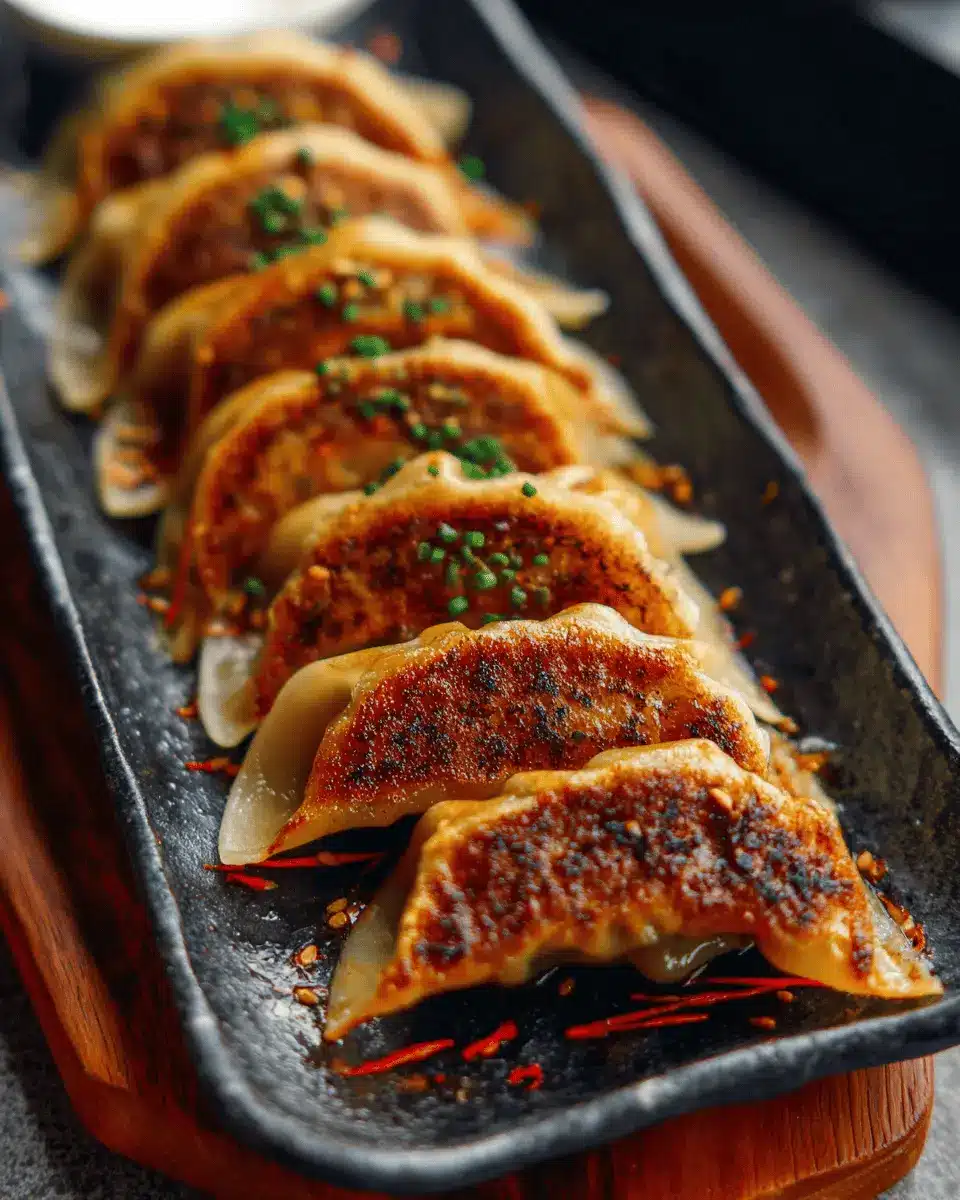
Serving suggestions for Japanese Gyoza Dumplings
Side dishes that complement gyoza
When serving Japanese gyoza dumplings, consider pairing them with vibrant, light side dishes to enhance their flavor. Some delicious options include:
- Sesame Spinach: Lightly sautéed spinach sprinkled with sesame seeds adds a nutty crunch.
- Miso Soup: The warm, umami-rich broth perfectly balances the crispy gyoza.
- Japanese Pickles (Tsukemono): Their tangy flavor acts as a refreshing contrast to the rich dumplings.
Best drinks to serve with gyoza
To wash down those delectable gyoza, opt for beverages that won't overpower their subtle flavors:
- Green Tea: This classic choice provides a refreshing, calming palate cleanser.
- Fruit-Infused Sparkling Water: A bubbly drink with citrus or berry notes complements the richness beautifully.
- Soda (like Yuzu or Ginger): Japanese sodas offer a fun twist that pairs surprisingly well with gyoza.
Enjoy crafting the perfect meal experience around your gyoza!
Time Breakdown for Japanese Gyoza Dumplings
Preparation Time
Get ready to dive into the world of gyoza! You’ll need about 1 hour to prepare the filling, assemble the dumplings, and get everything prepped for cooking. It’s a fun hands-on experience, especially when friends or family join in!
Cooking Time
Once they’re all assembled, cooking takes just 15 minutes. That’s right, in a short time, you’ll have crispy, golden dumplings ready for dipping.
Total Time
From start to finish, you’re looking at a total of 1 hour and 15 minutes to make these delicious Japanese Gyoza Dumplings. Perfect for a satisfying meal or a special appetizer at your next gathering!
For more insights on making dumplings, check out Serious Eats for expert tips on crafting the perfect filling.
Nutritional Facts for Japanese Gyoza Dumplings
Calories per serving
Each serving of Japanese gyoza dumplings contains approximately 208 calories. This makes them a delightful snack or appetizer without loading up on excess calories.
Macronutrient breakdown
In terms of macronutrients, you’ll find that each serving has:
- Carbohydrates: 24g
- Protein: 9g
- Fat: 8g (of which 4g is saturated fat)
These dumplings offer a balanced mix of nutrients, providing protein for muscle health and carbs for energy. For more nutritional benefits, you might want to check out Healthline’s insights on balanced diets. Enjoy gyoza while keeping your health goals in mind!
FAQs about Japanese Gyoza Dumplings
How do I store leftover gyoza?
Leftover Japanese gyoza dumplings can be stored in an airtight container in the refrigerator for up to three days. When you’re ready to enjoy them again, simply reheat in a skillet with a splash of water to steam them back to life or pan-fry for that crispy goodness.
Can gyoza be frozen before cooking?
Absolutely! You can freeze uncooked gyoza for up to three months. Lay them out in a single layer on a baking sheet until frozen, then transfer them to a freezer bag. Just remember not to defrost before cooking; go straight from freezer to skillet for the best texture.
What can I use instead of gyoza wrappers?
If you can’t find gyoza wrappers, consider using wonton wrappers or even homemade dumpling dough. Alternatively, thinly sliced vegetables like zucchini can be a fun, gluten-free option! For more wrapper alternatives, check out this guide on dumpling wrappers.
These tips should help you enjoy your Japanese gyoza dumplings long after making them!
Conclusion on Japanese Gyoza Dumplings
Japanese gyoza dumplings are a delightful culinary experience, blending crispy textures with flavorful fillings. Perfect for gatherings or a cozy night in, they are versatile enough for any taste preference. Don’t hesitate to experiment with different fillings or dipping sauces to make them your own! Enjoy!
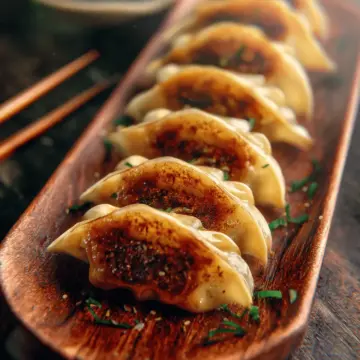
Japanese Gyoza Dumplings
Equipment
- food processor
- nonstick skillet
- colander
- plastic wrap or parchment paper
Ingredients
Filling Ingredients
- 1 pound napa cabbage about 5 cups, roughly chopped into large pieces
- 8 ounces ground pork 70% to 80% lean
- 1 clove garlic smashed
- 1.5 teaspoons fresh ginger minced
- 1 unit scallion chopped
- 2 tablespoons vegetable oil plus more for pan-frying
- 0.5 teaspoon sesame oil
- 2 teaspoons soy sauce
- 0.75 teaspoon sugar
- 0.5 teaspoon salt
- 0.125 teaspoon white pepper
- store-bought gyoza wrappers
Dipping Sauce Ingredients
- 2 tablespoons soy sauce
- 1 teaspoon rice vinegar
- 1 tablespoon hot water
- 1 teaspoon sugar
Instructions
Main Instructions
- Begin by blanching the napa cabbage in boiling water for 30 seconds. Drain the cabbage in a colander and rinse with cold water. Squeeze any excess water from the cabbage with your hands.
- To the food processor, add the blanched cabbage, ground pork, smashed garlic, ginger, scallion, 2 tablespoons vegetable oil, sesame oil, soy sauce, sugar, salt and pepper. Pulse the mixture in the food processor until the filling is well-combined.
- Prepare sheet pans or cookie sheets lined with plastic wrap or parchment paper. To assemble the gyoza, place about 2 teaspoons of filling in the middle of each wrapper, and use your finger dipped in a small bowl of fresh water to moisten the outer edges of the wrapper. You could simply fold them in half, or you can pleat them as you see in the photos. Make sure they are well-sealed.
- Heat a tablespoon of cooking oil in a nonstick or cast iron skillet over medium high heat. Place the gyoza in the pan and fry until the bottom of the gyoza become crispy and golden, about 2-3 minutes.
- When the gyoza have fried, add 1 tablespoon of water to the hot pan and immediately cover the pan to steam the dumplings. Let the gyoza to steam until the water has evaporated (about 2 minutes), remove the cover, and continue cooking until the bottoms of the gyoza get crispy again.
- Prepare your dipping sauce by combining all the sauce ingredients in a small bowl, and serve alongside the crispy gyoza!


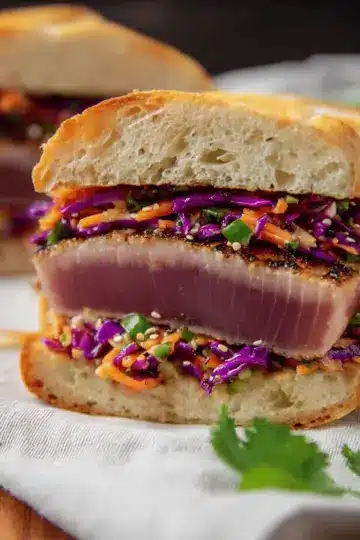


Leave a Reply